January Non-Farm Employment Report Outlook - In-depth Analysis of Market Expectations and Potential Impacts
- 2025年2月8日
- Posted by: Macro Global Markets
- Category: News


The number of non-agricultural jobs in the United States increased significantly by 256,000 in December, far exceeding market expectations of 160,000, and the unemployment rate also dropped from 4.2% to 4.1%, reflecting the continued hot job market. Although this data usually puts pressure on gold prices, the yellow metal quickly rebounded after a brief decline, rising by more than $30. Considering that December is the peak employment season and is affected by natural disasters, non-agricultural data is expected to remain strong in the future. After the release of non-agricultural data, U.S. stocks performed poorly, U.S. Treasury yields rose, and market expectations for the Federal Reserve to cut interest rates in 2025 weakened. Some analysts even believed that the interest rate hike cycle might be restarted.
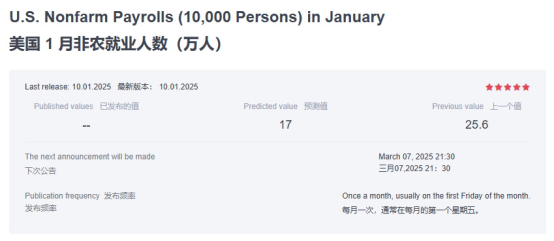
(1) Non-agricultural data released is not as expected: the weak US job market is bearish for the US dollar and bullish for gold;
(2) Non-agricultural data released exceeded expectations: The US job market is good, which is bullish for the US dollar and bearish for gold.
Interpretation of non-agricultural forecast
The U.S. economy added 256,000 jobs in December, and although average hourly wage growth slowed, the annual growth rate remained high at nearly 4%. Strong job and wage growth could stoke concerns that inflation will rise again in the coming months, especially against the backdrop of tariffs that Trump initiated on Feb. 1. That could cause market participants to renew questions about whether the Fed needs to cut interest rates twice this year.
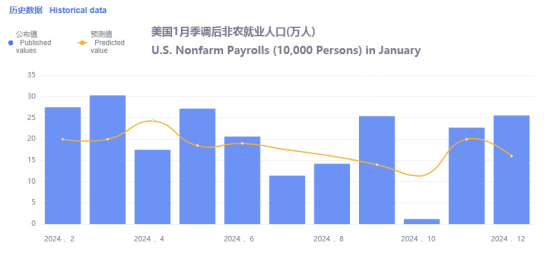
Currently, the US inflation rate is 2.7%, still far from the target of 2%, while consumers' inflation expectations for the next five to ten years have risen to 3.3%. The probability of the Fed cutting interest rates in January has dropped to 2.7%, the probability of maintaining the current interest rate unchanged in March is 75.5%, and the probability of not cutting interest rates at all this year has risen to 25.3%. The market has formed an expectation that the number of interest rate cuts will decrease and the magnitude will be smaller. From a macro perspective, the interest rate environment for global companies seems to be improving.
Analysis of the ADP report
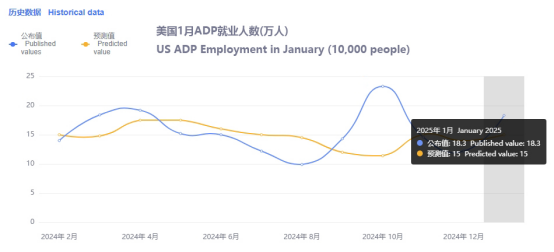
While falling job openings and slowing wage growth show some signs of adjustment, employers are still hiring and layoffs remain mild. Federal Reserve officials are closely monitoring changes in the labor market as they assess how much to cut interest rates this year. A rapid rise in unemployment last summer was a key factor in pushing for a 1 percentage point cut in interest rates in 2024, but the job market has since shown new life, with Federal Reserve Chairman Jerome Powell describing it last week as "fairly stable." ADP chief economist Nella Richardson noted that job growth in January was mainly concentrated in the service industry, especially trade, transportation, and leisure and hotel industries, while job growth in business services and production was weaker. In addition, employment in construction and mining increased, but employment in manufacturing decreased.
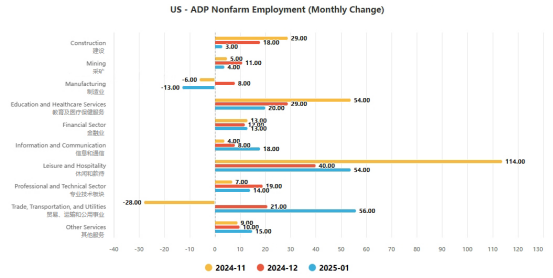
Goldman Sachs issued a special "warning"
The non-agricultural outlook for February 2025 shows that the US non-agricultural employment report will undergo major adjustments. The U.S. Bureau of Labor Statistics (BLS) will include the annual benchmark revision for the household survey when it releases the January nonfarm report on February 7, 2025. This revision will re-anchor the non-institutional resident population to the latest census projections, leading to revisions to indicators such as the labor force and household employment. Non-agricultural data comes from business surveys and household surveys, the latter of which covers a broader employment situation but has long been lower than business survey data.
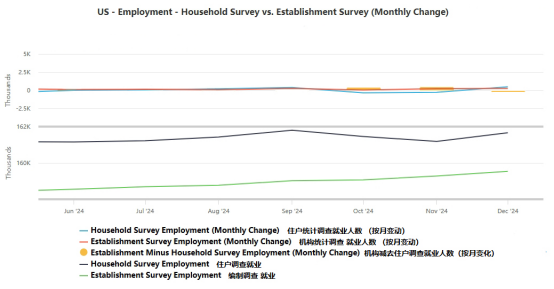
This revision will have a disproportionate impact on certain population groups. Immigrants are more likely to be young Hispanic or Asian, according to the 2023 American Community Survey, and the revisions would disproportionately boost the size of those groups. Because these groups have above-average labor force participation and unemployment rates, the revisions would raise the overall labor force participation and unemployment rates. However, Goldman Sachs warned that since the Census Bureau does not take immigration status into account when allocating the revised population, the estimates of the labor force participation rate and unemployment rate may be inaccurate, especially since the labor force participation rate of new immigrants is usually lower than that of non-immigrants.
After the revision, the total labor force is expected to increase by 2.5 million, household employment to increase by 2.3 million, the labor force participation rate to increase by 11 basis points, and the unemployment rate to increase by 4 basis points. The U.S. Census Bureau projects that population growth will return to normal in 2025, at about 1.9 million people, and Goldman Sachs expects its household survey population growth assumptions to be consistent with that rate. This means that the non-agricultural sector will usher in the biggest adjustment in history, and the unemployment rate may rise by 4 basis points!
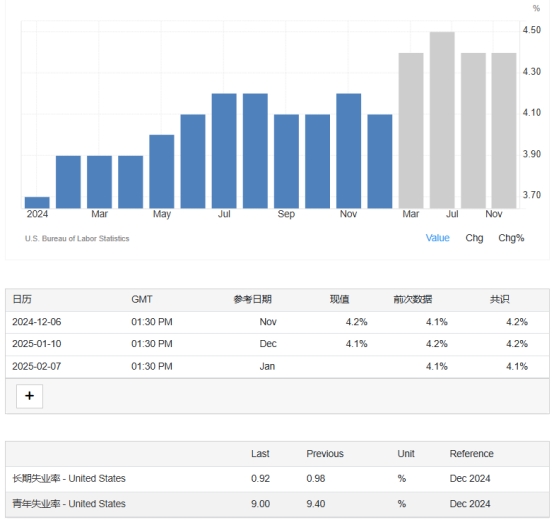
Affected by US President Trump's tariff policy, gold has risen for five consecutive trading days, continuing to set new historical highs. Trump said earlier that he would impose tariffs on Canada, Mexico and China on February 1, which caused gold to rise at the end of January and set a new historical high. After that, Trump suspended the imposition of tariffs on Canada and Mexico and continued to impose tariffs on China, which caused the US dollar to plummet, creating an opportunity for gold to rise further on Monday. On Tuesday, China announced its measures to impose additional tariffs on the United States, and the Sino-US trade dispute intensified, creating an opportunity for gold to rise further on Wednesday. The tariffs on the United States are announced every year.
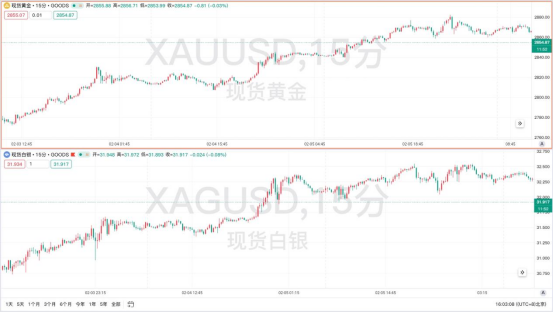
On the daily chart, gold has set new historical highs for five consecutive days, and its short-term performance is very strong. For gold's lower support, pay attention to the level of $2,860 where gold prices rose and fell back to stabilize on Wednesday, followed by Tuesday's high of $2,845; for gold's upper pressure, gold prices were mainly under pressure at $2,872 in the Asian and European sessions on Wednesday, followed by the historical high of $2,882. If it continues to break through, pay attention to the integer level of $2,900. The 5-day moving average and the MACD indicator form a golden cross upward, the RSI indicator forms a golden cross upward and enters the overbought area, and the KDJ indicator forms a golden cross in the overbought area and turns slightly downward. Technically, the bulls continue to maintain their advantage, but we need to pay attention to the short-term overbought adjustment risk.
Silver trend analysis:
From a technical perspective, silver's price trend remains tightly constrained, but as the market digests the Fed's stance and Trump's economic policies, the possibility of a silver price breakthrough is increasing. If Powell suggests that rate cuts remain a distant prospect, silver could face near-term resistance with downside targets at $29.50 and $29.00. However, any dovish comments from the Fed could push silver prices above $30.98, paving the way for a move towards $31.81 and above. Traders should prepare for heightened volatility following the Fed’s decision, with silver’s next move largely dependent on Powell’s tone and any unexpected developments from the White House.
